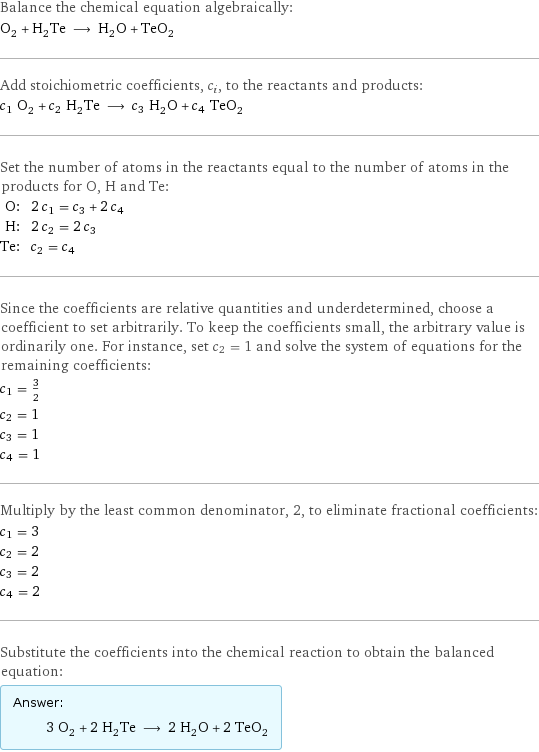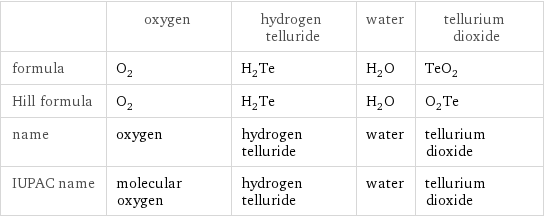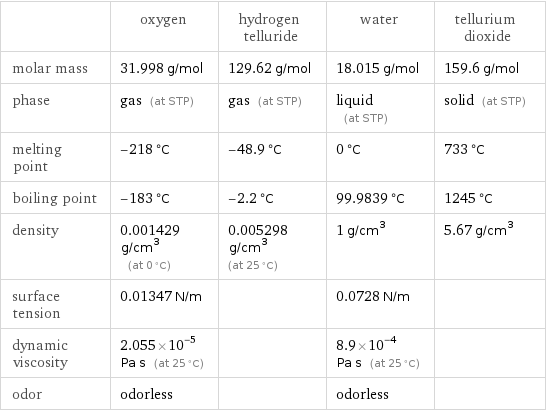Input interpretation

O_2 oxygen + H_2Te hydrogen telluride ⟶ H_2O water + TeO_2 tellurium dioxide
Balanced equation

Balance the chemical equation algebraically: O_2 + H_2Te ⟶ H_2O + TeO_2 Add stoichiometric coefficients, c_i, to the reactants and products: c_1 O_2 + c_2 H_2Te ⟶ c_3 H_2O + c_4 TeO_2 Set the number of atoms in the reactants equal to the number of atoms in the products for O, H and Te: O: | 2 c_1 = c_3 + 2 c_4 H: | 2 c_2 = 2 c_3 Te: | c_2 = c_4 Since the coefficients are relative quantities and underdetermined, choose a coefficient to set arbitrarily. To keep the coefficients small, the arbitrary value is ordinarily one. For instance, set c_2 = 1 and solve the system of equations for the remaining coefficients: c_1 = 3/2 c_2 = 1 c_3 = 1 c_4 = 1 Multiply by the least common denominator, 2, to eliminate fractional coefficients: c_1 = 3 c_2 = 2 c_3 = 2 c_4 = 2 Substitute the coefficients into the chemical reaction to obtain the balanced equation: Answer: | | 3 O_2 + 2 H_2Te ⟶ 2 H_2O + 2 TeO_2
Structures

+ ⟶ +
Names

oxygen + hydrogen telluride ⟶ water + tellurium dioxide
Reaction thermodynamics
Enthalpy

| oxygen | hydrogen telluride | water | tellurium dioxide molecular enthalpy | 0 kJ/mol | 99.6 kJ/mol | -285.8 kJ/mol | -322.6 kJ/mol total enthalpy | 0 kJ/mol | 199.2 kJ/mol | -571.7 kJ/mol | -645.2 kJ/mol | H_initial = 199.2 kJ/mol | | H_final = -1217 kJ/mol | ΔH_rxn^0 | -1217 kJ/mol - 199.2 kJ/mol = -1416 kJ/mol (exothermic) | | |
Equilibrium constant
![Construct the equilibrium constant, K, expression for: O_2 + H_2Te ⟶ H_2O + TeO_2 Plan: • Balance the chemical equation. • Determine the stoichiometric numbers. • Assemble the activity expression for each chemical species. • Use the activity expressions to build the equilibrium constant expression. Write the balanced chemical equation: 3 O_2 + 2 H_2Te ⟶ 2 H_2O + 2 TeO_2 Assign stoichiometric numbers, ν_i, using the stoichiometric coefficients, c_i, from the balanced chemical equation in the following manner: ν_i = -c_i for reactants and ν_i = c_i for products: chemical species | c_i | ν_i O_2 | 3 | -3 H_2Te | 2 | -2 H_2O | 2 | 2 TeO_2 | 2 | 2 Assemble the activity expressions accounting for the state of matter and ν_i: chemical species | c_i | ν_i | activity expression O_2 | 3 | -3 | ([O2])^(-3) H_2Te | 2 | -2 | ([H2Te])^(-2) H_2O | 2 | 2 | ([H2O])^2 TeO_2 | 2 | 2 | ([TeO2])^2 The equilibrium constant symbol in the concentration basis is: K_c Mulitply the activity expressions to arrive at the K_c expression: Answer: | | K_c = ([O2])^(-3) ([H2Te])^(-2) ([H2O])^2 ([TeO2])^2 = (([H2O])^2 ([TeO2])^2)/(([O2])^3 ([H2Te])^2)](../image_source/8d5d66fe0293bfcbe934465434c3d3c2.png)
Construct the equilibrium constant, K, expression for: O_2 + H_2Te ⟶ H_2O + TeO_2 Plan: • Balance the chemical equation. • Determine the stoichiometric numbers. • Assemble the activity expression for each chemical species. • Use the activity expressions to build the equilibrium constant expression. Write the balanced chemical equation: 3 O_2 + 2 H_2Te ⟶ 2 H_2O + 2 TeO_2 Assign stoichiometric numbers, ν_i, using the stoichiometric coefficients, c_i, from the balanced chemical equation in the following manner: ν_i = -c_i for reactants and ν_i = c_i for products: chemical species | c_i | ν_i O_2 | 3 | -3 H_2Te | 2 | -2 H_2O | 2 | 2 TeO_2 | 2 | 2 Assemble the activity expressions accounting for the state of matter and ν_i: chemical species | c_i | ν_i | activity expression O_2 | 3 | -3 | ([O2])^(-3) H_2Te | 2 | -2 | ([H2Te])^(-2) H_2O | 2 | 2 | ([H2O])^2 TeO_2 | 2 | 2 | ([TeO2])^2 The equilibrium constant symbol in the concentration basis is: K_c Mulitply the activity expressions to arrive at the K_c expression: Answer: | | K_c = ([O2])^(-3) ([H2Te])^(-2) ([H2O])^2 ([TeO2])^2 = (([H2O])^2 ([TeO2])^2)/(([O2])^3 ([H2Te])^2)
Rate of reaction
![Construct the rate of reaction expression for: O_2 + H_2Te ⟶ H_2O + TeO_2 Plan: • Balance the chemical equation. • Determine the stoichiometric numbers. • Assemble the rate term for each chemical species. • Write the rate of reaction expression. Write the balanced chemical equation: 3 O_2 + 2 H_2Te ⟶ 2 H_2O + 2 TeO_2 Assign stoichiometric numbers, ν_i, using the stoichiometric coefficients, c_i, from the balanced chemical equation in the following manner: ν_i = -c_i for reactants and ν_i = c_i for products: chemical species | c_i | ν_i O_2 | 3 | -3 H_2Te | 2 | -2 H_2O | 2 | 2 TeO_2 | 2 | 2 The rate term for each chemical species, B_i, is 1/ν_i(Δ[B_i])/(Δt) where [B_i] is the amount concentration and t is time: chemical species | c_i | ν_i | rate term O_2 | 3 | -3 | -1/3 (Δ[O2])/(Δt) H_2Te | 2 | -2 | -1/2 (Δ[H2Te])/(Δt) H_2O | 2 | 2 | 1/2 (Δ[H2O])/(Δt) TeO_2 | 2 | 2 | 1/2 (Δ[TeO2])/(Δt) (for infinitesimal rate of change, replace Δ with d) Set the rate terms equal to each other to arrive at the rate expression: Answer: | | rate = -1/3 (Δ[O2])/(Δt) = -1/2 (Δ[H2Te])/(Δt) = 1/2 (Δ[H2O])/(Δt) = 1/2 (Δ[TeO2])/(Δt) (assuming constant volume and no accumulation of intermediates or side products)](../image_source/6480671035c00fbe797a98cfcbe074c8.png)
Construct the rate of reaction expression for: O_2 + H_2Te ⟶ H_2O + TeO_2 Plan: • Balance the chemical equation. • Determine the stoichiometric numbers. • Assemble the rate term for each chemical species. • Write the rate of reaction expression. Write the balanced chemical equation: 3 O_2 + 2 H_2Te ⟶ 2 H_2O + 2 TeO_2 Assign stoichiometric numbers, ν_i, using the stoichiometric coefficients, c_i, from the balanced chemical equation in the following manner: ν_i = -c_i for reactants and ν_i = c_i for products: chemical species | c_i | ν_i O_2 | 3 | -3 H_2Te | 2 | -2 H_2O | 2 | 2 TeO_2 | 2 | 2 The rate term for each chemical species, B_i, is 1/ν_i(Δ[B_i])/(Δt) where [B_i] is the amount concentration and t is time: chemical species | c_i | ν_i | rate term O_2 | 3 | -3 | -1/3 (Δ[O2])/(Δt) H_2Te | 2 | -2 | -1/2 (Δ[H2Te])/(Δt) H_2O | 2 | 2 | 1/2 (Δ[H2O])/(Δt) TeO_2 | 2 | 2 | 1/2 (Δ[TeO2])/(Δt) (for infinitesimal rate of change, replace Δ with d) Set the rate terms equal to each other to arrive at the rate expression: Answer: | | rate = -1/3 (Δ[O2])/(Δt) = -1/2 (Δ[H2Te])/(Δt) = 1/2 (Δ[H2O])/(Δt) = 1/2 (Δ[TeO2])/(Δt) (assuming constant volume and no accumulation of intermediates or side products)
Chemical names and formulas

| oxygen | hydrogen telluride | water | tellurium dioxide formula | O_2 | H_2Te | H_2O | TeO_2 Hill formula | O_2 | H_2Te | H_2O | O_2Te name | oxygen | hydrogen telluride | water | tellurium dioxide IUPAC name | molecular oxygen | hydrogen telluride | water | tellurium dioxide
Substance properties

| oxygen | hydrogen telluride | water | tellurium dioxide molar mass | 31.998 g/mol | 129.62 g/mol | 18.015 g/mol | 159.6 g/mol phase | gas (at STP) | gas (at STP) | liquid (at STP) | solid (at STP) melting point | -218 °C | -48.9 °C | 0 °C | 733 °C boiling point | -183 °C | -2.2 °C | 99.9839 °C | 1245 °C density | 0.001429 g/cm^3 (at 0 °C) | 0.005298 g/cm^3 (at 25 °C) | 1 g/cm^3 | 5.67 g/cm^3 surface tension | 0.01347 N/m | | 0.0728 N/m | dynamic viscosity | 2.055×10^-5 Pa s (at 25 °C) | | 8.9×10^-4 Pa s (at 25 °C) | odor | odorless | | odorless |
Units
